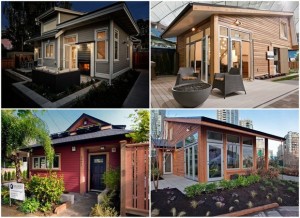- Little backyard houses — aka “accessory dwelling units” — are springing up all over Vancouver.
 This is a partial remedy to the affordable rental shortage that afflicts municipalities all over North America, including Vermont. It also affords an optional living arrangement for older people who want to age in place. In Vancouver, these appendages are called “laneway houses,” and some of them are pretty handsome. There’s plenty of room for additions like this in Burlington, even if we don’t have alleys — and in plenty of other Vermont communities, too.
This is a partial remedy to the affordable rental shortage that afflicts municipalities all over North America, including Vermont. It also affords an optional living arrangement for older people who want to age in place. In Vancouver, these appendages are called “laneway houses,” and some of them are pretty handsome. There’s plenty of room for additions like this in Burlington, even if we don’t have alleys — and in plenty of other Vermont communities, too. - A “mobility program” in heavily segregated Baltimore moves families from high-poverty public housing complexes in the city to higher-rent, higher-opportunity suburbs. This is an initiative very much in the spirit of affirmatively furthering fair housing, but it serves a small fraction of the subsidy-eligible families in need and it operates largely under the radar, to minimize opposition. One obstacle: a shortage of affordable housing in suburban communities.
- Plattsburgh has a new 64-unit affordable housing complex, called Homestead on Ampersand.
 It’s just a couple of miles from the neighborhood where complaints about a proposal for a smaller affordable housing complex prevailed.
It’s just a couple of miles from the neighborhood where complaints about a proposal for a smaller affordable housing complex prevailed. - Columbus, Ohio, plans to transform a vacant downtown building into “workforce housing” – which in this case means housing for people who make $40,000 to $60,000 a year. The made-over building would feature micro units – apartments of 300 square feet or so and targeted, presumably, to single Millennials. We’ve touched on the micro movement before, which seems to be taking hold mostly in bigger metro areas (here’s a roundup with a national map; for a more substantial study of the phenomenon, click here). But it has also spread to Kalamazoo and, as we’ve noted, Syracuse, so there’s no reason it couldn’t work in an over-priced city like Burlington, where officialdom is forever wringing its hands about how young professionals have trouble finding affordable accommodations.
Tag Archives: micro-units
Scaling back, sort of
A new verb, or gerund, is twittering its way into the contemporary housing lexicon: “co-living.”
It’s often paired with “co-working,” another neologism, and “micro-housing.” These words are being used most commonly to describe the emerging lifestyles of highly driven, hard-striving young entrepreneurs, typically in technical fields — Millennial start-up wannabes, they’re sometimes called in the literature. Harnessed to their ambitions, they’re willing to live in tiny spaces with some common amenities (co-live), work in open-space offices where they can freely network and brainstorm with peers (co-work), and abandon the idea of maintaining a conventional “work-life balance.”
Harnessed to their ambitions, they’re willing to live in tiny spaces with some common amenities (co-live), work in open-space offices where they can freely network and brainstorm with peers (co-work), and abandon the idea of maintaining a conventional “work-life balance.”
These patterns reportedly originated in the Bay Area, as you might expect, but are showing up in New York. This summer, the Times ran a story about Pure House, one of several businesses renting apartments with amenities to such people who are willing to pay $1,600 to $4,000 a month to share rooms with others of their ilk. “The Millennial Commune,” read the headline. (For BuzzFeed’s elaboration on this phenomenon, click here.)
We’ve never met anybody like that, but we take it on faith that such people really do exist. What we’d like to suggest, though, is that some variant of co-living might have appeal for ordinary people, too – Millennials and oldsters, alike. We’ll explain in a moment, but first, let’s be clear that co-living is not the same as cohousing.
Cohousing, as the Cohousing Association of the United States describes it, is “an intentional community of private homes clustered around shared space.” There are many variations of this basic idea of combining private and communal space, and a couple of dozen of these communities have sprung up around Vermont. These are clustered developments, but they’re not necessarily adduced as an answer to the housing-unaffordability problem because of the added costs associated with the shared facilities.
Co-living, by contrast, puts people in tiny apartments (say, 200-300 square feet) with access to some shared space (such as a communal kitchen and lounge). Typically, these are furnished rentals.
An example is Commonspace, 21 micro units being developed on two floors of a five story building in Syracuse, N.Y., above a co-working office space. Each unit will have a bathroom and a kitchenette and will rent from $700 to $900 a month — supposedly slightly less than a one-bedroom apartment goes for in Syracuse, according to a fine profile in The Atlantic. 
Quite apart from the “co-working” annex, micro-units have proliferated in Seattle over the last few years and appear to appeal especially to people who want to live close by where they work.
Now obviously, this sort of place is not for everyone. It means, among other things, giving up the idea that you’ll be paying for living quarters big enough to hold all your seldom-used stuff.
But it might make sense for lots of people — recent college grads working their first jobs, dislocated workers or homeless people getting back on their feet, retirees living on fixed incomes. Not that all these people would necessarily have live together, but assorted communities might suggest themselves.
And beyond rentals, perhaps different ownership models could be devised by land trusts, using judicious public subsidies, all with an eye to affordability.